BP's CSR Challenges: Sustainability and Integrated Reporting Solutions
VerifiedAdded on 2021/06/17
|7
|2109
|56
Report
AI Summary
This report examines the application of sustainability reporting and integrated reporting within the context of corporate social responsibility (CSR), using the BP Deepwater Horizon oil spill as a case study. It begins by defining sustainability reporting as a method to inform stakeholders about a company's economic, environmental, social, and governance performance, emphasizing transparency and accountability. The report then explores integrated reporting, which combines financial and non-financial information to provide a holistic view of an organization's value creation, long-term objectives, and stakeholder relationships. The analysis highlights how both methods can address the challenges BP faced after the disaster, helping to rebuild trust with investors and the public. The report concludes by emphasizing the benefits of these reporting techniques in improving internal processes, engaging stakeholders, and demonstrating a commitment to sustainable development. The report also provides a detailed comparison between sustainability reporting and integrated reporting and how they can be used together to achieve organizational goals.
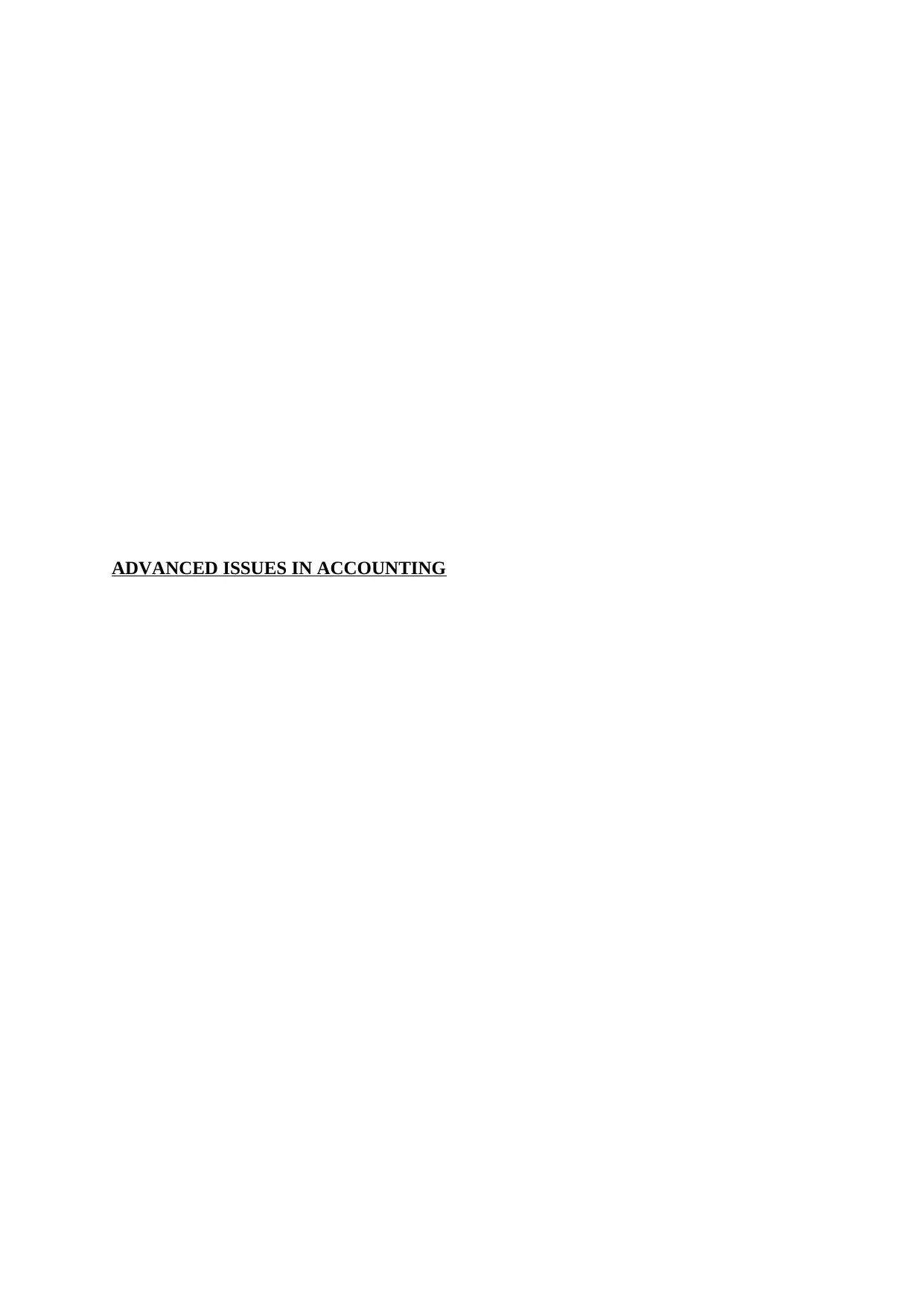
ADVANCED ISSUES IN ACCOUNTING
Paraphrase This Document
Need a fresh take? Get an instant paraphrase of this document with our AI Paraphraser
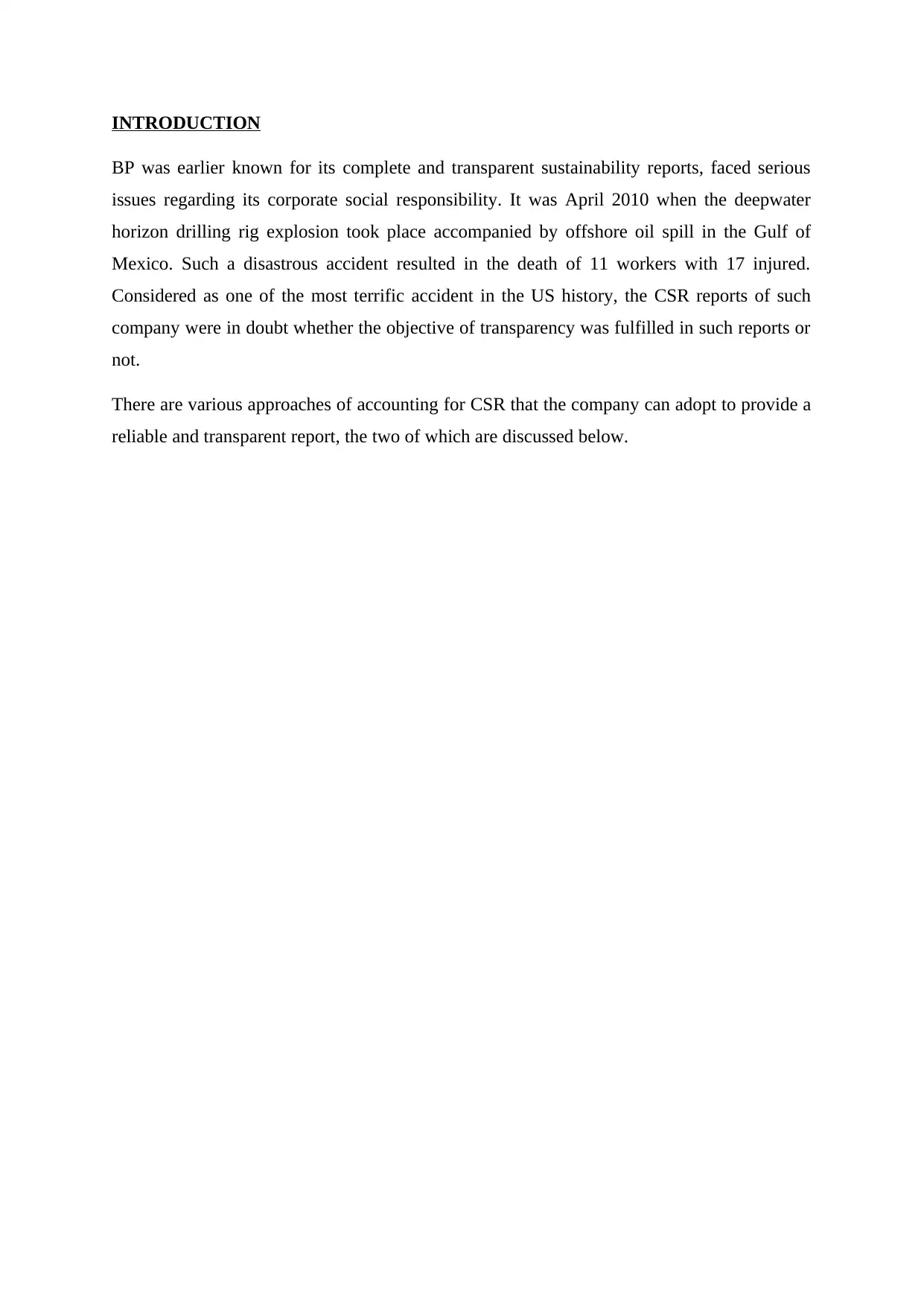
INTRODUCTION
BP was earlier known for its complete and transparent sustainability reports, faced serious
issues regarding its corporate social responsibility. It was April 2010 when the deepwater
horizon drilling rig explosion took place accompanied by offshore oil spill in the Gulf of
Mexico. Such a disastrous accident resulted in the death of 11 workers with 17 injured.
Considered as one of the most terrific accident in the US history, the CSR reports of such
company were in doubt whether the objective of transparency was fulfilled in such reports or
not.
There are various approaches of accounting for CSR that the company can adopt to provide a
reliable and transparent report, the two of which are discussed below.
BP was earlier known for its complete and transparent sustainability reports, faced serious
issues regarding its corporate social responsibility. It was April 2010 when the deepwater
horizon drilling rig explosion took place accompanied by offshore oil spill in the Gulf of
Mexico. Such a disastrous accident resulted in the death of 11 workers with 17 injured.
Considered as one of the most terrific accident in the US history, the CSR reports of such
company were in doubt whether the objective of transparency was fulfilled in such reports or
not.
There are various approaches of accounting for CSR that the company can adopt to provide a
reliable and transparent report, the two of which are discussed below.
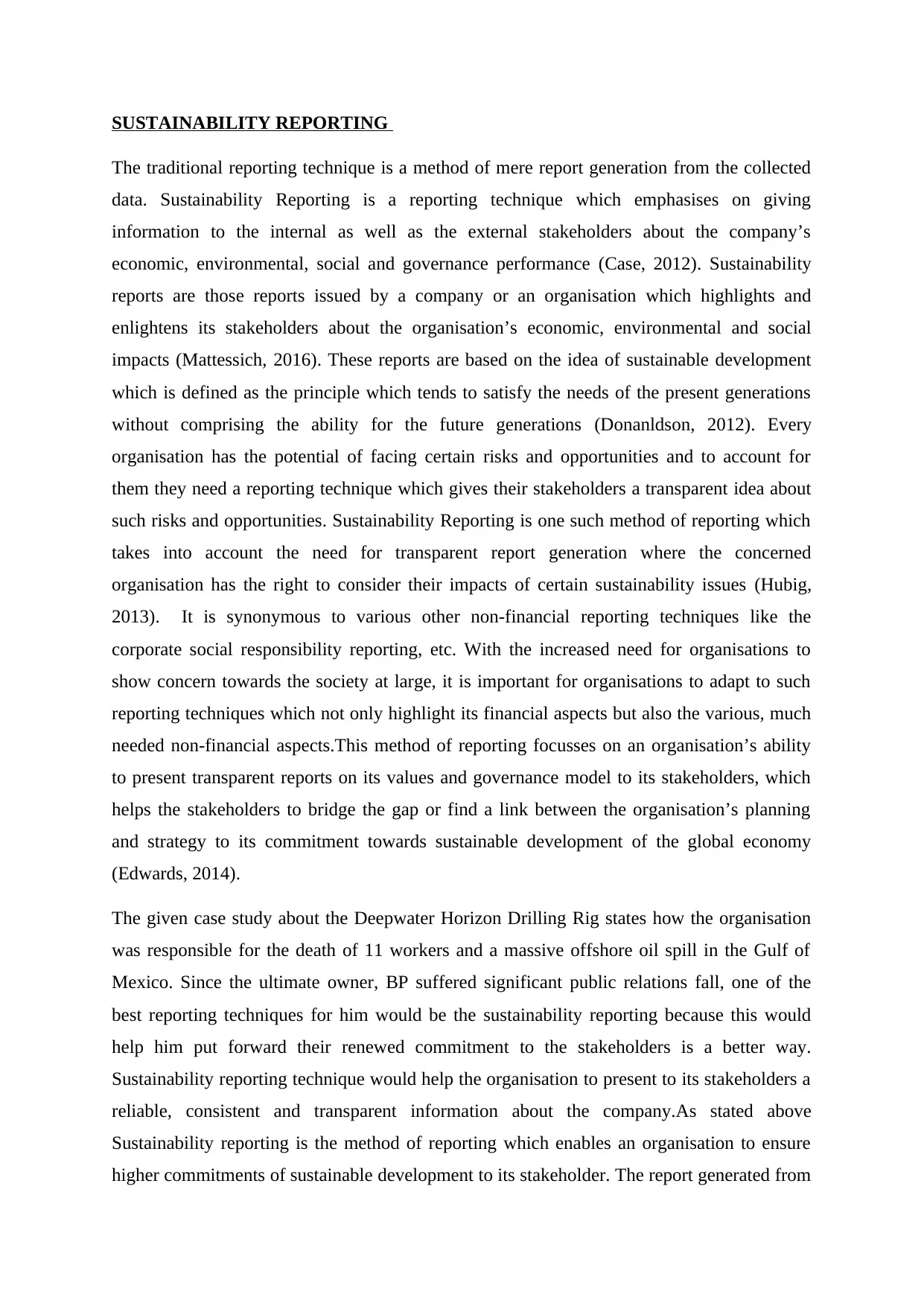
SUSTAINABILITY REPORTING
The traditional reporting technique is a method of mere report generation from the collected
data. Sustainability Reporting is a reporting technique which emphasises on giving
information to the internal as well as the external stakeholders about the company’s
economic, environmental, social and governance performance (Case, 2012). Sustainability
reports are those reports issued by a company or an organisation which highlights and
enlightens its stakeholders about the organisation’s economic, environmental and social
impacts (Mattessich, 2016). These reports are based on the idea of sustainable development
which is defined as the principle which tends to satisfy the needs of the present generations
without comprising the ability for the future generations (Donanldson, 2012). Every
organisation has the potential of facing certain risks and opportunities and to account for
them they need a reporting technique which gives their stakeholders a transparent idea about
such risks and opportunities. Sustainability Reporting is one such method of reporting which
takes into account the need for transparent report generation where the concerned
organisation has the right to consider their impacts of certain sustainability issues (Hubig,
2013). It is synonymous to various other non-financial reporting techniques like the
corporate social responsibility reporting, etc. With the increased need for organisations to
show concern towards the society at large, it is important for organisations to adapt to such
reporting techniques which not only highlight its financial aspects but also the various, much
needed non-financial aspects.This method of reporting focusses on an organisation’s ability
to present transparent reports on its values and governance model to its stakeholders, which
helps the stakeholders to bridge the gap or find a link between the organisation’s planning
and strategy to its commitment towards sustainable development of the global economy
(Edwards, 2014).
The given case study about the Deepwater Horizon Drilling Rig states how the organisation
was responsible for the death of 11 workers and a massive offshore oil spill in the Gulf of
Mexico. Since the ultimate owner, BP suffered significant public relations fall, one of the
best reporting techniques for him would be the sustainability reporting because this would
help him put forward their renewed commitment to the stakeholders is a better way.
Sustainability reporting technique would help the organisation to present to its stakeholders a
reliable, consistent and transparent information about the company.As stated above
Sustainability reporting is the method of reporting which enables an organisation to ensure
higher commitments of sustainable development to its stakeholder. The report generated from
The traditional reporting technique is a method of mere report generation from the collected
data. Sustainability Reporting is a reporting technique which emphasises on giving
information to the internal as well as the external stakeholders about the company’s
economic, environmental, social and governance performance (Case, 2012). Sustainability
reports are those reports issued by a company or an organisation which highlights and
enlightens its stakeholders about the organisation’s economic, environmental and social
impacts (Mattessich, 2016). These reports are based on the idea of sustainable development
which is defined as the principle which tends to satisfy the needs of the present generations
without comprising the ability for the future generations (Donanldson, 2012). Every
organisation has the potential of facing certain risks and opportunities and to account for
them they need a reporting technique which gives their stakeholders a transparent idea about
such risks and opportunities. Sustainability Reporting is one such method of reporting which
takes into account the need for transparent report generation where the concerned
organisation has the right to consider their impacts of certain sustainability issues (Hubig,
2013). It is synonymous to various other non-financial reporting techniques like the
corporate social responsibility reporting, etc. With the increased need for organisations to
show concern towards the society at large, it is important for organisations to adapt to such
reporting techniques which not only highlight its financial aspects but also the various, much
needed non-financial aspects.This method of reporting focusses on an organisation’s ability
to present transparent reports on its values and governance model to its stakeholders, which
helps the stakeholders to bridge the gap or find a link between the organisation’s planning
and strategy to its commitment towards sustainable development of the global economy
(Edwards, 2014).
The given case study about the Deepwater Horizon Drilling Rig states how the organisation
was responsible for the death of 11 workers and a massive offshore oil spill in the Gulf of
Mexico. Since the ultimate owner, BP suffered significant public relations fall, one of the
best reporting techniques for him would be the sustainability reporting because this would
help him put forward their renewed commitment to the stakeholders is a better way.
Sustainability reporting technique would help the organisation to present to its stakeholders a
reliable, consistent and transparent information about the company.As stated above
Sustainability reporting is the method of reporting which enables an organisation to ensure
higher commitments of sustainable development to its stakeholder. The report generated from
⊘ This is a preview!⊘
Do you want full access?
Subscribe today to unlock all pages.

Trusted by 1+ million students worldwide
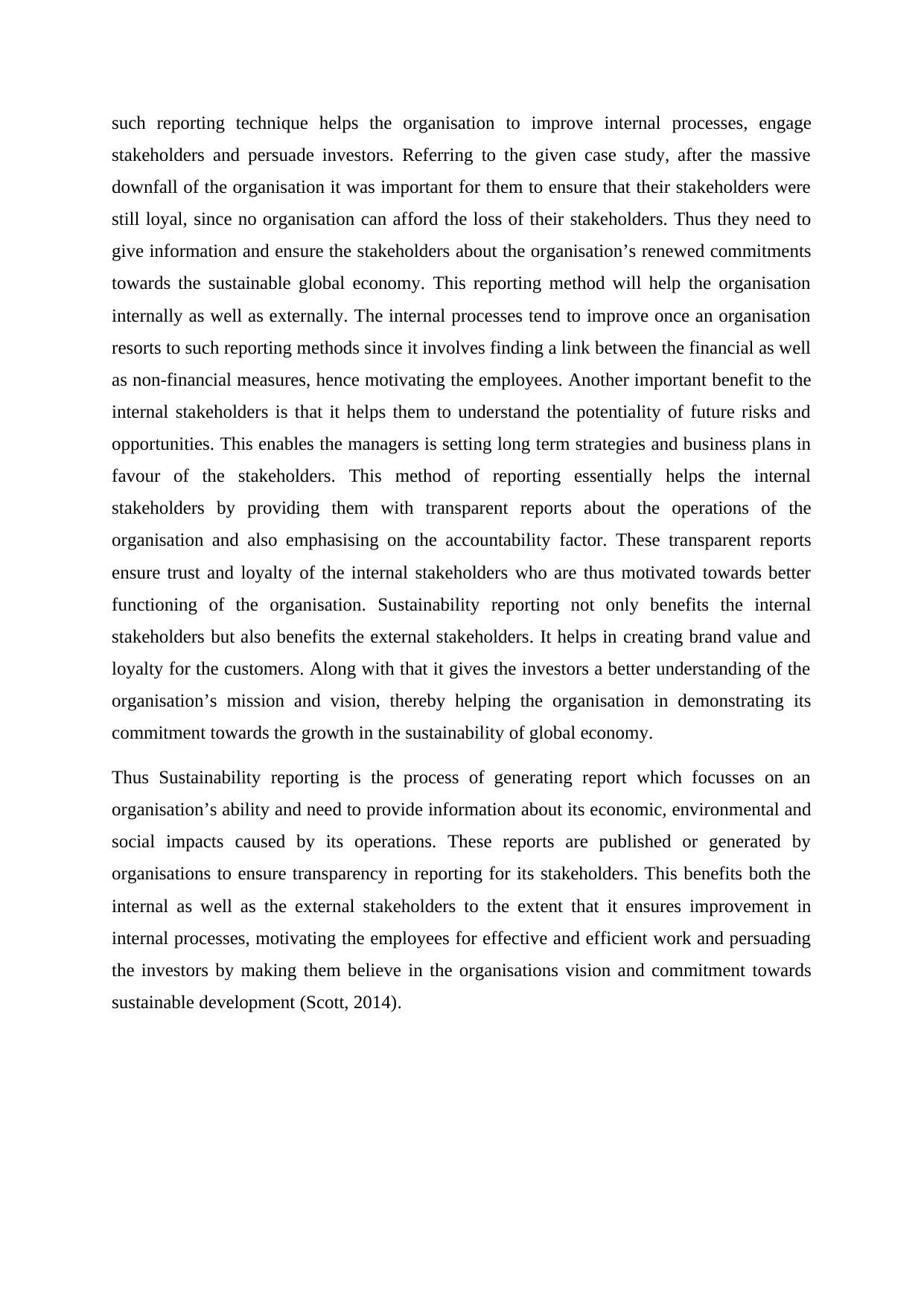
such reporting technique helps the organisation to improve internal processes, engage
stakeholders and persuade investors. Referring to the given case study, after the massive
downfall of the organisation it was important for them to ensure that their stakeholders were
still loyal, since no organisation can afford the loss of their stakeholders. Thus they need to
give information and ensure the stakeholders about the organisation’s renewed commitments
towards the sustainable global economy. This reporting method will help the organisation
internally as well as externally. The internal processes tend to improve once an organisation
resorts to such reporting methods since it involves finding a link between the financial as well
as non-financial measures, hence motivating the employees. Another important benefit to the
internal stakeholders is that it helps them to understand the potentiality of future risks and
opportunities. This enables the managers is setting long term strategies and business plans in
favour of the stakeholders. This method of reporting essentially helps the internal
stakeholders by providing them with transparent reports about the operations of the
organisation and also emphasising on the accountability factor. These transparent reports
ensure trust and loyalty of the internal stakeholders who are thus motivated towards better
functioning of the organisation. Sustainability reporting not only benefits the internal
stakeholders but also benefits the external stakeholders. It helps in creating brand value and
loyalty for the customers. Along with that it gives the investors a better understanding of the
organisation’s mission and vision, thereby helping the organisation in demonstrating its
commitment towards the growth in the sustainability of global economy.
Thus Sustainability reporting is the process of generating report which focusses on an
organisation’s ability and need to provide information about its economic, environmental and
social impacts caused by its operations. These reports are published or generated by
organisations to ensure transparency in reporting for its stakeholders. This benefits both the
internal as well as the external stakeholders to the extent that it ensures improvement in
internal processes, motivating the employees for effective and efficient work and persuading
the investors by making them believe in the organisations vision and commitment towards
sustainable development (Scott, 2014).
stakeholders and persuade investors. Referring to the given case study, after the massive
downfall of the organisation it was important for them to ensure that their stakeholders were
still loyal, since no organisation can afford the loss of their stakeholders. Thus they need to
give information and ensure the stakeholders about the organisation’s renewed commitments
towards the sustainable global economy. This reporting method will help the organisation
internally as well as externally. The internal processes tend to improve once an organisation
resorts to such reporting methods since it involves finding a link between the financial as well
as non-financial measures, hence motivating the employees. Another important benefit to the
internal stakeholders is that it helps them to understand the potentiality of future risks and
opportunities. This enables the managers is setting long term strategies and business plans in
favour of the stakeholders. This method of reporting essentially helps the internal
stakeholders by providing them with transparent reports about the operations of the
organisation and also emphasising on the accountability factor. These transparent reports
ensure trust and loyalty of the internal stakeholders who are thus motivated towards better
functioning of the organisation. Sustainability reporting not only benefits the internal
stakeholders but also benefits the external stakeholders. It helps in creating brand value and
loyalty for the customers. Along with that it gives the investors a better understanding of the
organisation’s mission and vision, thereby helping the organisation in demonstrating its
commitment towards the growth in the sustainability of global economy.
Thus Sustainability reporting is the process of generating report which focusses on an
organisation’s ability and need to provide information about its economic, environmental and
social impacts caused by its operations. These reports are published or generated by
organisations to ensure transparency in reporting for its stakeholders. This benefits both the
internal as well as the external stakeholders to the extent that it ensures improvement in
internal processes, motivating the employees for effective and efficient work and persuading
the investors by making them believe in the organisations vision and commitment towards
sustainable development (Scott, 2014).
Paraphrase This Document
Need a fresh take? Get an instant paraphrase of this document with our AI Paraphraser
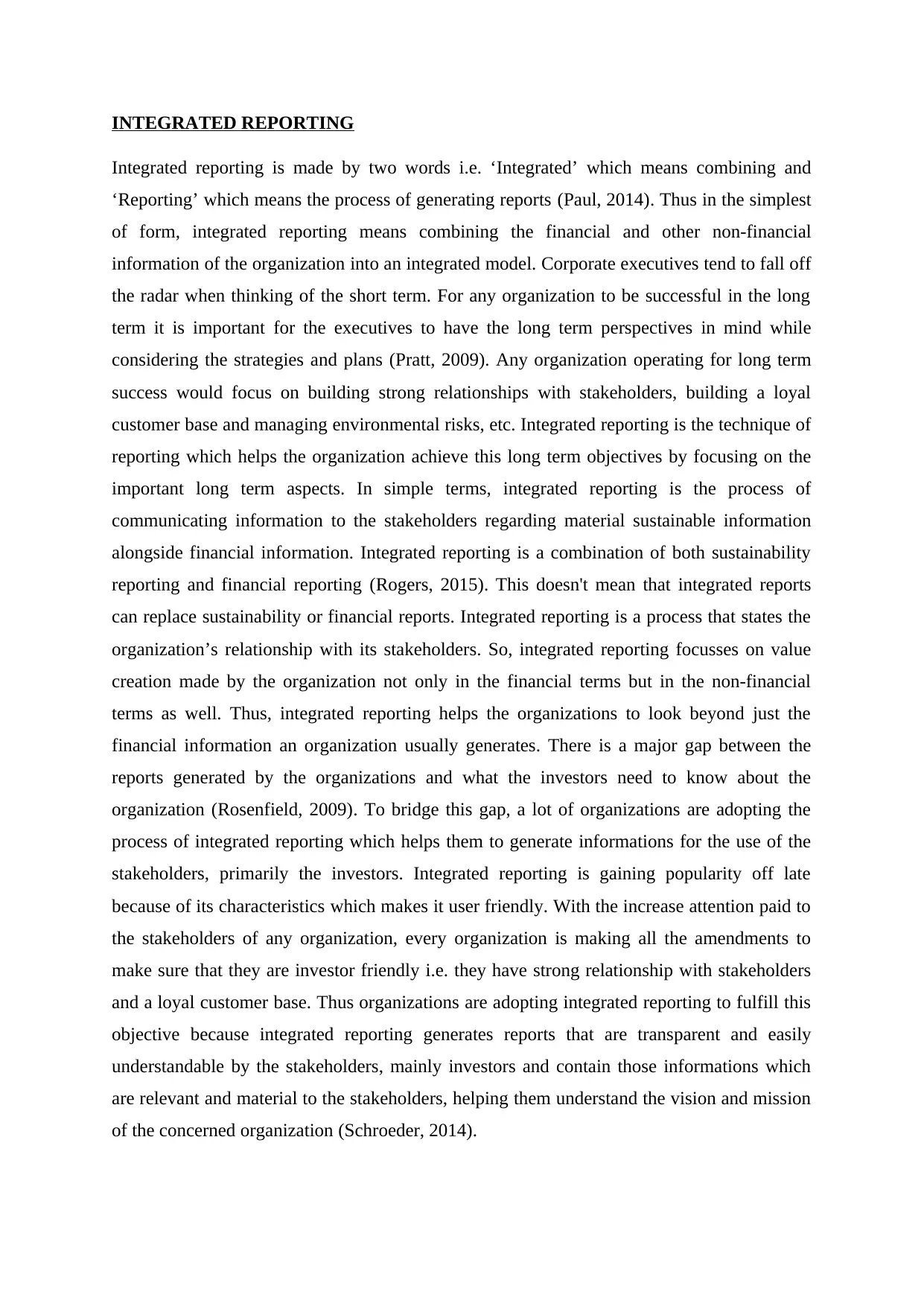
INTEGRATED REPORTING
Integrated reporting is made by two words i.e. ‘Integrated’ which means combining and
‘Reporting’ which means the process of generating reports (Paul, 2014). Thus in the simplest
of form, integrated reporting means combining the financial and other non-financial
information of the organization into an integrated model. Corporate executives tend to fall off
the radar when thinking of the short term. For any organization to be successful in the long
term it is important for the executives to have the long term perspectives in mind while
considering the strategies and plans (Pratt, 2009). Any organization operating for long term
success would focus on building strong relationships with stakeholders, building a loyal
customer base and managing environmental risks, etc. Integrated reporting is the technique of
reporting which helps the organization achieve this long term objectives by focusing on the
important long term aspects. In simple terms, integrated reporting is the process of
communicating information to the stakeholders regarding material sustainable information
alongside financial information. Integrated reporting is a combination of both sustainability
reporting and financial reporting (Rogers, 2015). This doesn't mean that integrated reports
can replace sustainability or financial reports. Integrated reporting is a process that states the
organization’s relationship with its stakeholders. So, integrated reporting focusses on value
creation made by the organization not only in the financial terms but in the non-financial
terms as well. Thus, integrated reporting helps the organizations to look beyond just the
financial information an organization usually generates. There is a major gap between the
reports generated by the organizations and what the investors need to know about the
organization (Rosenfield, 2009). To bridge this gap, a lot of organizations are adopting the
process of integrated reporting which helps them to generate informations for the use of the
stakeholders, primarily the investors. Integrated reporting is gaining popularity off late
because of its characteristics which makes it user friendly. With the increase attention paid to
the stakeholders of any organization, every organization is making all the amendments to
make sure that they are investor friendly i.e. they have strong relationship with stakeholders
and a loyal customer base. Thus organizations are adopting integrated reporting to fulfill this
objective because integrated reporting generates reports that are transparent and easily
understandable by the stakeholders, mainly investors and contain those informations which
are relevant and material to the stakeholders, helping them understand the vision and mission
of the concerned organization (Schroeder, 2014).
Integrated reporting is made by two words i.e. ‘Integrated’ which means combining and
‘Reporting’ which means the process of generating reports (Paul, 2014). Thus in the simplest
of form, integrated reporting means combining the financial and other non-financial
information of the organization into an integrated model. Corporate executives tend to fall off
the radar when thinking of the short term. For any organization to be successful in the long
term it is important for the executives to have the long term perspectives in mind while
considering the strategies and plans (Pratt, 2009). Any organization operating for long term
success would focus on building strong relationships with stakeholders, building a loyal
customer base and managing environmental risks, etc. Integrated reporting is the technique of
reporting which helps the organization achieve this long term objectives by focusing on the
important long term aspects. In simple terms, integrated reporting is the process of
communicating information to the stakeholders regarding material sustainable information
alongside financial information. Integrated reporting is a combination of both sustainability
reporting and financial reporting (Rogers, 2015). This doesn't mean that integrated reports
can replace sustainability or financial reports. Integrated reporting is a process that states the
organization’s relationship with its stakeholders. So, integrated reporting focusses on value
creation made by the organization not only in the financial terms but in the non-financial
terms as well. Thus, integrated reporting helps the organizations to look beyond just the
financial information an organization usually generates. There is a major gap between the
reports generated by the organizations and what the investors need to know about the
organization (Rosenfield, 2009). To bridge this gap, a lot of organizations are adopting the
process of integrated reporting which helps them to generate informations for the use of the
stakeholders, primarily the investors. Integrated reporting is gaining popularity off late
because of its characteristics which makes it user friendly. With the increase attention paid to
the stakeholders of any organization, every organization is making all the amendments to
make sure that they are investor friendly i.e. they have strong relationship with stakeholders
and a loyal customer base. Thus organizations are adopting integrated reporting to fulfill this
objective because integrated reporting generates reports that are transparent and easily
understandable by the stakeholders, mainly investors and contain those informations which
are relevant and material to the stakeholders, helping them understand the vision and mission
of the concerned organization (Schroeder, 2014).
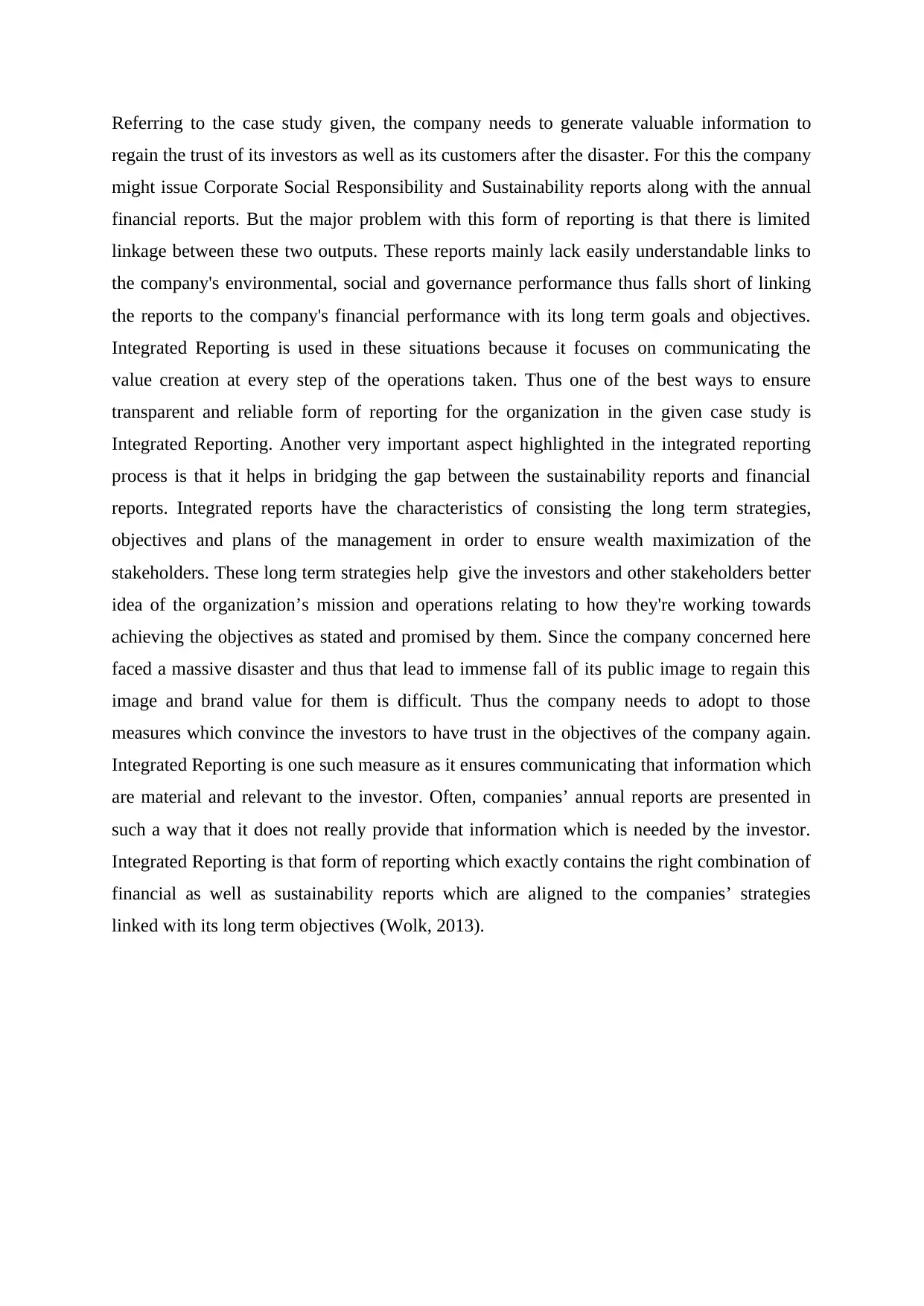
Referring to the case study given, the company needs to generate valuable information to
regain the trust of its investors as well as its customers after the disaster. For this the company
might issue Corporate Social Responsibility and Sustainability reports along with the annual
financial reports. But the major problem with this form of reporting is that there is limited
linkage between these two outputs. These reports mainly lack easily understandable links to
the company's environmental, social and governance performance thus falls short of linking
the reports to the company's financial performance with its long term goals and objectives.
Integrated Reporting is used in these situations because it focuses on communicating the
value creation at every step of the operations taken. Thus one of the best ways to ensure
transparent and reliable form of reporting for the organization in the given case study is
Integrated Reporting. Another very important aspect highlighted in the integrated reporting
process is that it helps in bridging the gap between the sustainability reports and financial
reports. Integrated reports have the characteristics of consisting the long term strategies,
objectives and plans of the management in order to ensure wealth maximization of the
stakeholders. These long term strategies help give the investors and other stakeholders better
idea of the organization’s mission and operations relating to how they're working towards
achieving the objectives as stated and promised by them. Since the company concerned here
faced a massive disaster and thus that lead to immense fall of its public image to regain this
image and brand value for them is difficult. Thus the company needs to adopt to those
measures which convince the investors to have trust in the objectives of the company again.
Integrated Reporting is one such measure as it ensures communicating that information which
are material and relevant to the investor. Often, companies’ annual reports are presented in
such a way that it does not really provide that information which is needed by the investor.
Integrated Reporting is that form of reporting which exactly contains the right combination of
financial as well as sustainability reports which are aligned to the companies’ strategies
linked with its long term objectives (Wolk, 2013).
regain the trust of its investors as well as its customers after the disaster. For this the company
might issue Corporate Social Responsibility and Sustainability reports along with the annual
financial reports. But the major problem with this form of reporting is that there is limited
linkage between these two outputs. These reports mainly lack easily understandable links to
the company's environmental, social and governance performance thus falls short of linking
the reports to the company's financial performance with its long term goals and objectives.
Integrated Reporting is used in these situations because it focuses on communicating the
value creation at every step of the operations taken. Thus one of the best ways to ensure
transparent and reliable form of reporting for the organization in the given case study is
Integrated Reporting. Another very important aspect highlighted in the integrated reporting
process is that it helps in bridging the gap between the sustainability reports and financial
reports. Integrated reports have the characteristics of consisting the long term strategies,
objectives and plans of the management in order to ensure wealth maximization of the
stakeholders. These long term strategies help give the investors and other stakeholders better
idea of the organization’s mission and operations relating to how they're working towards
achieving the objectives as stated and promised by them. Since the company concerned here
faced a massive disaster and thus that lead to immense fall of its public image to regain this
image and brand value for them is difficult. Thus the company needs to adopt to those
measures which convince the investors to have trust in the objectives of the company again.
Integrated Reporting is one such measure as it ensures communicating that information which
are material and relevant to the investor. Often, companies’ annual reports are presented in
such a way that it does not really provide that information which is needed by the investor.
Integrated Reporting is that form of reporting which exactly contains the right combination of
financial as well as sustainability reports which are aligned to the companies’ strategies
linked with its long term objectives (Wolk, 2013).
⊘ This is a preview!⊘
Do you want full access?
Subscribe today to unlock all pages.

Trusted by 1+ million students worldwide
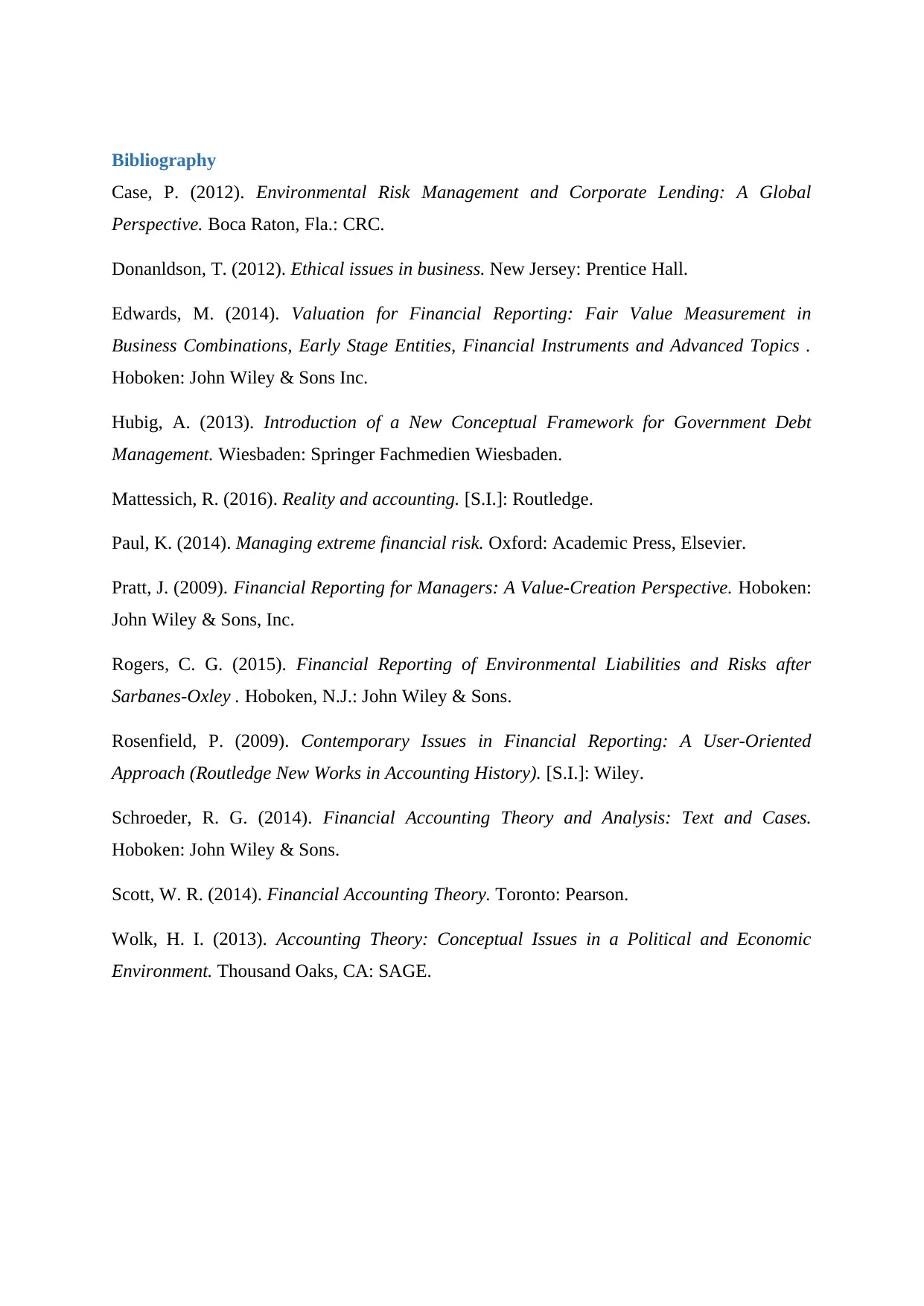
Bibliography
Case, P. (2012). Environmental Risk Management and Corporate Lending: A Global
Perspective. Boca Raton, Fla.: CRC.
Donanldson, T. (2012). Ethical issues in business. New Jersey: Prentice Hall.
Edwards, M. (2014). Valuation for Financial Reporting: Fair Value Measurement in
Business Combinations, Early Stage Entities, Financial Instruments and Advanced Topics .
Hoboken: John Wiley & Sons Inc.
Hubig, A. (2013). Introduction of a New Conceptual Framework for Government Debt
Management. Wiesbaden: Springer Fachmedien Wiesbaden.
Mattessich, R. (2016). Reality and accounting. [S.I.]: Routledge.
Paul, K. (2014). Managing extreme financial risk. Oxford: Academic Press, Elsevier.
Pratt, J. (2009). Financial Reporting for Managers: A Value-Creation Perspective. Hoboken:
John Wiley & Sons, Inc.
Rogers, C. G. (2015). Financial Reporting of Environmental Liabilities and Risks after
Sarbanes-Oxley . Hoboken, N.J.: John Wiley & Sons.
Rosenfield, P. (2009). Contemporary Issues in Financial Reporting: A User-Oriented
Approach (Routledge New Works in Accounting History). [S.I.]: Wiley.
Schroeder, R. G. (2014). Financial Accounting Theory and Analysis: Text and Cases.
Hoboken: John Wiley & Sons.
Scott, W. R. (2014). Financial Accounting Theory. Toronto: Pearson.
Wolk, H. I. (2013). Accounting Theory: Conceptual Issues in a Political and Economic
Environment. Thousand Oaks, CA: SAGE.
Case, P. (2012). Environmental Risk Management and Corporate Lending: A Global
Perspective. Boca Raton, Fla.: CRC.
Donanldson, T. (2012). Ethical issues in business. New Jersey: Prentice Hall.
Edwards, M. (2014). Valuation for Financial Reporting: Fair Value Measurement in
Business Combinations, Early Stage Entities, Financial Instruments and Advanced Topics .
Hoboken: John Wiley & Sons Inc.
Hubig, A. (2013). Introduction of a New Conceptual Framework for Government Debt
Management. Wiesbaden: Springer Fachmedien Wiesbaden.
Mattessich, R. (2016). Reality and accounting. [S.I.]: Routledge.
Paul, K. (2014). Managing extreme financial risk. Oxford: Academic Press, Elsevier.
Pratt, J. (2009). Financial Reporting for Managers: A Value-Creation Perspective. Hoboken:
John Wiley & Sons, Inc.
Rogers, C. G. (2015). Financial Reporting of Environmental Liabilities and Risks after
Sarbanes-Oxley . Hoboken, N.J.: John Wiley & Sons.
Rosenfield, P. (2009). Contemporary Issues in Financial Reporting: A User-Oriented
Approach (Routledge New Works in Accounting History). [S.I.]: Wiley.
Schroeder, R. G. (2014). Financial Accounting Theory and Analysis: Text and Cases.
Hoboken: John Wiley & Sons.
Scott, W. R. (2014). Financial Accounting Theory. Toronto: Pearson.
Wolk, H. I. (2013). Accounting Theory: Conceptual Issues in a Political and Economic
Environment. Thousand Oaks, CA: SAGE.
1 out of 7
Related Documents
Your All-in-One AI-Powered Toolkit for Academic Success.
+13062052269
info@desklib.com
Available 24*7 on WhatsApp / Email
![[object Object]](/_next/static/media/star-bottom.7253800d.svg)
Unlock your academic potential
Copyright © 2020–2025 A2Z Services. All Rights Reserved. Developed and managed by ZUCOL.





